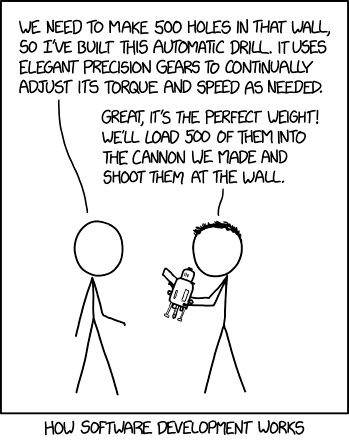# Batch Farm
Let's take a look at a model of how you can submit a job from one
computer and have it run on many other computers.
:::{figure-md} BatchManager-fig
:align: center
 An example of a batch system managing multiple instances of a program on multiple computers.
:::
You can probably guess how things flow from top to bottom in the above
figure: You submit a program from your computer; we'll get into how
that happens later. The computer that receives the submission is the
"batch manager". The batch manager looks over its collection of "batch
nodes", that is, a group of computers that do nothing else but run
users' program remotely.
The batch manager keeps track of which copy of your program has been
submitted to which node. It also controls which copy is actually
running on a given node. Other copies of your program are "on hold",
waiting until a queue on that batch node is free for your program to
start running.
Of course, your programs are being interleaved with the programs
submitted by all the other users of this "batch farm."
"Hey, if I have to run my program just five times, what's the point of all
this fuss?" Don't forget the "more" principle: I've seen researchers
submit 20,000 instances of their program to be executed on a batch
farm. You may not need a batch system now, but if you continue your
scientific research, you almost certainly will in the future.
:::{figure-md} software_development-fig
:align: center
An example of a batch system managing multiple instances of a program on multiple computers.
:::
You can probably guess how things flow from top to bottom in the above
figure: You submit a program from your computer; we'll get into how
that happens later. The computer that receives the submission is the
"batch manager". The batch manager looks over its collection of "batch
nodes", that is, a group of computers that do nothing else but run
users' program remotely.
The batch manager keeps track of which copy of your program has been
submitted to which node. It also controls which copy is actually
running on a given node. Other copies of your program are "on hold",
waiting until a queue on that batch node is free for your program to
start running.
Of course, your programs are being interleaved with the programs
submitted by all the other users of this "batch farm."
"Hey, if I have to run my program just five times, what's the point of all
this fuss?" Don't forget the "more" principle: I've seen researchers
submit 20,000 instances of their program to be executed on a batch
farm. You may not need a batch system now, but if you continue your
scientific research, you almost certainly will in the future.
:::{figure-md} software_development-fig
:align: center
 by Randall Munroe
:::
by Randall Munroe
:::
 An example of a batch system managing multiple instances of a program on multiple computers.
:::
You can probably guess how things flow from top to bottom in the above
figure: You submit a program from your computer; we'll get into how
that happens later. The computer that receives the submission is the
"batch manager". The batch manager looks over its collection of "batch
nodes", that is, a group of computers that do nothing else but run
users' program remotely.
The batch manager keeps track of which copy of your program has been
submitted to which node. It also controls which copy is actually
running on a given node. Other copies of your program are "on hold",
waiting until a queue on that batch node is free for your program to
start running.
Of course, your programs are being interleaved with the programs
submitted by all the other users of this "batch farm."
"Hey, if I have to run my program just five times, what's the point of all
this fuss?" Don't forget the "more" principle: I've seen researchers
submit 20,000 instances of their program to be executed on a batch
farm. You may not need a batch system now, but if you continue your
scientific research, you almost certainly will in the future.
:::{figure-md} software_development-fig
:align: center
An example of a batch system managing multiple instances of a program on multiple computers.
:::
You can probably guess how things flow from top to bottom in the above
figure: You submit a program from your computer; we'll get into how
that happens later. The computer that receives the submission is the
"batch manager". The batch manager looks over its collection of "batch
nodes", that is, a group of computers that do nothing else but run
users' program remotely.
The batch manager keeps track of which copy of your program has been
submitted to which node. It also controls which copy is actually
running on a given node. Other copies of your program are "on hold",
waiting until a queue on that batch node is free for your program to
start running.
Of course, your programs are being interleaved with the programs
submitted by all the other users of this "batch farm."
"Hey, if I have to run my program just five times, what's the point of all
this fuss?" Don't forget the "more" principle: I've seen researchers
submit 20,000 instances of their program to be executed on a batch
farm. You may not need a batch system now, but if you continue your
scientific research, you almost certainly will in the future.
:::{figure-md} software_development-fig
:align: center
